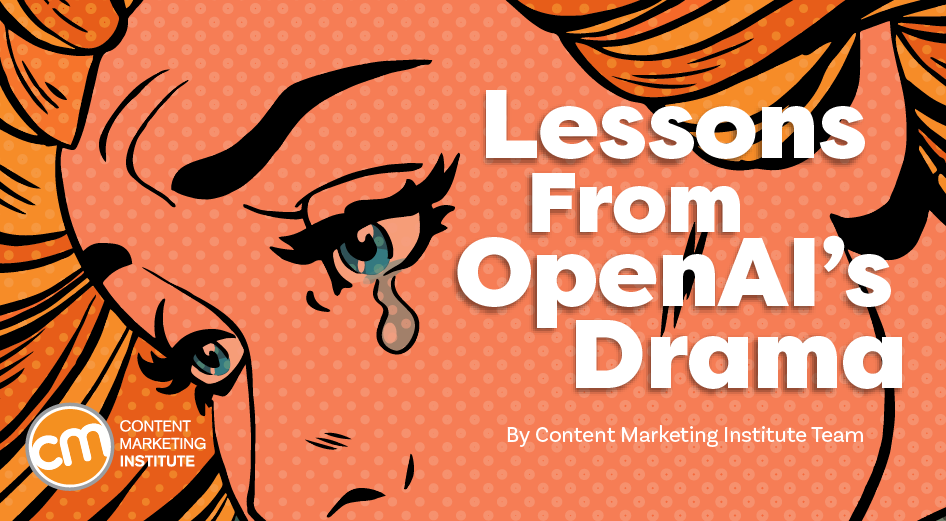History will remember the 2010s for its significant trends – those that remain popular (the rise of the Marvel and DC universes, hipster fashion, social media) and those we’d like to forget all about (planking, anyone?).
In marketing circles, the decade marked a giant leap in the evolution of content marketing. Much of the shift can be traced back to Google’s Zero Moment of Truth study, which found that 88% of consumers research products and services before purchasing. This study amplified the need for better search engine optimization (SEO) across brands of all sizes and, of course, more content to fuel those SEO efforts.
Fast forward to 2023, and content marketing has cemented its role as a cornerstone of B2B marketing strategy. According to CMI’s research, some 71% of B2B marketers say content became more important to their organization (compared to the previous year), and year-over-year investments in content increased, as well.

Alongside the rise in the importance of content came the need for brands to create more of it. That means adding more production capabilities and resources – and more content creators with specialty skills. As brands juggle these demands, how do marketers continue to expand their content without exceeding their budgets?
For consideration: In-house content creation vs. outsourcing
Along with the challenges of a changing content marketing landscape comes a need to revisit how teams are built. This includes the marketing space, where budgets are extra sensitive to return-on-investment (ROI) analysis.
To lower marketing overhead, many companies opt for a “jack-of-all-trades” approach for hiring, which can leave a talent gap for craftspeople in many areas, including content creation.
The scales are tipping in favor of outsourcing content production. But the jury is still out.
Savvy marketers love in-house content production for the unparalleled control it gives them over all stages of the process. In-house teams:
- receive in-depth training on products and solutions
- get regular updates as products evolve
- live and breathe the brand voice more deeply and consistently
- are embedded in company culture and can rapidly shift alongside business goals.
However, those same teams come with high salaries, benefits, and other costs that many businesses don’t want to shoulder in today’s economic environment. Further, in-house resources are fairly static and often limited to skills available within their team, making it difficult to adapt to specialized content needs or new content formats.

Switching to an outsourced approach opens up new possibilities:
- Need an article on a niche technology? Find an expert writer.
- Need an infographic designed in a specific style? Look for a specialized designer.
- Need a series of sales enablement videos? Hire a video creator.
When done right, outsourcing your content production frees up internal marketing resources to focus on other growth areas while ensuring content production stays on track. It allows brands to scale content creation up or down, depending on needs and provides the flexibility to produce a wider variety of content types while keeping fixed costs low. That makes it easier to fuel all marketing programs that need content.

Yet, B2B marketing executives tend to get nervous when the topic of content outsourcing gets floated by management. At ClearVoice, we’ve heard all the objections, including:
- “Industry experts” who haven’t been adequately vetted
- disappearing freelancers who need to be replaced with no notice
- time and focus lost to editing and rewriting lackluster content
- lack of collaboration between the in-house team and outsourced resources.
Elevate your #contentmarketing but not your budget! Explore why outsourcing content is the game-changer you need, says @ClearVoice via @CMIContent #sponsored Click To Tweet
However, getting executive buy-in is critical to the success of any marketing program, so exploring the cost-benefits of outsourcing is essential. Let’s explore the core benefits of outsourcing content production to a reliable partner.
11 core benefits of outsourcing content production
- More content, same spend. With the right partner, outsourcing often results in more bang for your marketing buck overall. Rather than spending money and resources on recruiting, training, and overhead, companies can use their resources to produce and distribute more content, which results in better ROI.
- Expertise, on-demand. Outsourcing enables you to hire industry experts fractionally, facilitating higher-quality and more accurate content. Building the same expertise in-house is time-consuming and expensive. A good partner has access to a proven network of expert talent.
- Scalability without new headcount. Your content needs may change throughout the year – sometimes you need a little content; other times, you need a lot! Outsourcing offers the flexibility to ramp up or down as needed. Look for a partner with a deep bench of talent to ensure this strategic benefit.
- Enough content to fuel needs across the enterprise. The marketing group isn’t the only team that needs regular content. Sales, internal communications, human resources, and other organizational functions might have varying content needs, which an outsourced solution can support. Outsourcing allows for consistent content across departments, whether it’s HR’s recruitment materials or sales’ product information one-sheets.
- Unwavering consistency. Creating great content requires a clear and consistent content production process codified through learning and repetition. Content agencies and other outsourced solutions like ClearVoice have developed their workflows by producing thousands of pieces of content. These standardized workflows ensure content remains consistent in quality, tone, and style – a critical factor in maintaining brand identity and trust.
- Quality assurance and control. Well-managed content production agencies have robust quality control checks in place. From editors to fact checkers to proofreaders, they ensure the content is polished and error-free and meets your needs and specifications, saving you the headaches of rounds and rounds of revisions.
- Time added to your day. For most marketers, one of the most time-consuming aspects of content creation is the actual production – from ideation to writing to editing. With the right content creation partner, your team can focus on core business tasks and additional business growth campaigns.
- Fresh perspectives. The ability to incorporate unique points of view into your content is a crucial differentiator for brands, but that can be difficult to achieve when your in-house team is stretched thin. By outsourcing, you bring in a new set of eyes and fresh perspectives to ensure your content remains engaging for the audience.
- Access to advanced tools and analytics. With the right content partner, you inherit their expertise – and access to the software, tools, and analytics they regularly use. Your brand can benefit directly without making an additional investment.
- Timely turnarounds. Content production providers have efficient workflows in place to deliver high-quality content on time, every time. This ensures that your marketing campaigns stay on schedule.
- Reliable feedback loops and iterative improvements. With expertise on demand and seamless workflows, you can provide and receive feedback quickly, allowing you to implement and continually optimize your content strategy easily.
Find your ideal approach
There are several viable approaches to outsourcing, depending on how your internal team is structured. They can be broken down into two broad categories:
- Contracting external creative talent to be managed by your in-house team.
- Partnering with a content creation agency or managed production solution like ClearVoice.
Hiring contractors
This is where most internal content marketing professionals begin – by hiring one-off resources. It’s important to remember that when going this route, you must factor in the time investment for tasks that include*:
- Talent sourcing and onboarding: 8 hours
- Ideation and briefing: 6 hours
- Managing content production: 4 hours
- CMS management: 1.5 hours
- Invoice management and payments: 1.5 hours
- Editing, revisions, writer coaching: 10 hours
- Replacing churned contractors: 2 hours
*Estimates, based on an average of 10 blogs per month.
You may notice these tasks are similar to those your full-time content team manages.

Partnering with a managed content creation solution
Content creation agencies come in all shapes and sizes. Some tout their expert content creators and workflows, while others feature their content creation platforms or low-cost solutions.
The crucial thing to remember when working with this type of solution is that you’re keeping as much of your content dollars as possible focused on the actual delivery of quality content.
Here is a quick list of questions to ask as you evaluate potential outsourcing solutions:
- Can they align with our content strategy?
- Are they familiar with our industry, audience, and audience’s pain points?
- How do they vet and onboard their content creators?
- How do they measure content quality?
- Can they scale their resources up or down based on our needs?
- What communication tools are in place for smooth collaboration?
- What is the process for revisions and feedback?
- What is the average turnaround time for different types of content?
- How do they price their services?
- Do they use technology-driven content creation tools such as AI?
- Does their portfolio align with our expectations?
- Who retains the rights to the content produced?
- Do they report on content performance? What metrics will they cover?
- Do they have customer stories or references we can contact?
- Do they offer additional services or expertise to help evolve our content marketing?

Torn between in-house vs. outsourced content? Dive into the strategic benefits of outsourcing for your #contentstrategy, says @ClearVoice via @CMIContent #sponsored Click To Tweet
The bottom line
The content marketing landscape continues to evolve, and so must your content production strategy.
While in-house teams offer brand knowledge and control, these benefits often come with substantial costs and can hinder flexibility. Conversely, outsourcing provides significant benefits – from scalability to the ability to produce varied content types – at a lower cost than hiring in-house talent.
The bottom line is that it’s about finding the right approach that aligns with your goals and can deliver consistent, high-quality content without taking your focus from other marketing and business priorities.

About ClearVoice
Creating content often takes a lot of trial and error, as well as time to find and vet writers and develop an editorial pipeline. Luckily, there are services that can help you hit the ground running with content production, contractor management, and content strategy.
ClearVoice provides brands and agencies with content that helps them rank and convert. Our in-house teams and contractor network of thousands of writers, producers, and creators work together to create quality content for all your marketing needs. Connect with us for a cost-effective approach to building and scaling your content program.






